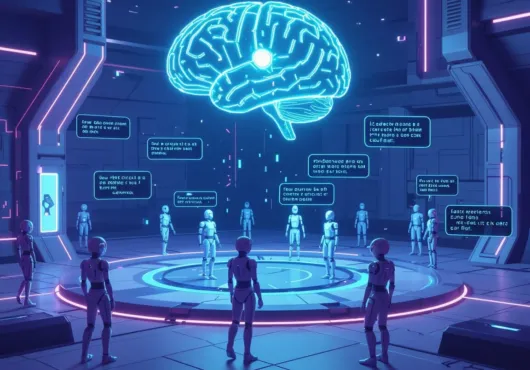(Spoiler: the future of intelligence might smell faintly of pizza boxes and solder.)
Like What You Read? Dive Deeper Into AI’s Real Impact.
Keep Reading- Walled gardens hoard compute and regulators; basements trade speed and transparency.
- Open-source LLMs = innovation & chaos—great for localization, great for deepfake kits.
- Hybrid future incoming: the best model may be born in a data center and raised on GitHub caffeine.
Meet the Two Factions
| Camp | Motto | Typical HQ | Favorite Flex |
|---|---|---|---|
| Walled-Garden Titans (OpenAI, Google DeepMind, Anthropic) | “Trust us, we’re safe ™.” | A data center cooled to tundra temps. | Benchmark charts with the y-axis stretched. |
| Open-Source Renegades (LLaMA derivatives, Mistral, RedPajama, tinyLLMs on GitHub) | “Fork it, ship it, break it.” | Someone’s spare-bedroom GPU rig. | Dropping full weights on HuggingFace at 2 a.m. |
Silicon Valley suits warn that open weights are a biohazard; basement devs counter that closed models are just corporate gatekeeping with a safety sticker.
Why the Basement Crowd Is Winning Mindshare
Iteration at Ludicrous Speed – One rando in Prague fine-tunes a 7-B parameter model on cat memes and accidentally invents the best sentiment detector for Gen-Z gloom.
Cost Crash – Thanks to LoRA, quantization, and laptops that run hotter than the sun, you can train a GPT-2-ish chatbot on weekend electricity money.
“Don’t Make Me Sign a 50-Page API TOS” – Researchers want to poke every neuron, not beg for a rate-limit raise.
Big Tech Still Owns the Heavy Artillery
Compute Cartel – You need data-center-level juice to reach GPT-4-class scale. Titans hoard H100s like Smaug on a graphics-card stash.
Data Dungeons – Licensing deals with Reddit, StackOverflow, and YouTube transcripts mean the biggest corp models inhale more raw internet than your local ISP handles in a decade.
Regulatory Lobbying – When governments sniff “AI risk,” guess whose white papers they read? (Hint: not the GitHub README with skull emojis.)
The Basement Boom—Good, Bad, and Ugly
| Upside | Downside |
|---|---|
| ✦ Grassroots innovation—edge devices, localized languages, accessibility for Global South. | ✦ Deepfake-as-a-service kits proliferate faster than Discord mods can ban them. |
| ✦ Security transparency—bugs exposed in daylight. | ✦ Malware models: code-gen that ships zero-day exploits on request. |
| ✦ Community red-teaming beats corporate PR audits. | ✦ No kill-switch: once weights leak, Pandora’s GPU never closes. |
Case Study: “Garage-GPT” Goes Viral
Phase 1: Three grad students snag used 3090 cards, crawl European Parliament speeches, fine-tune a bilingual legal LLM.
Phase 2: Lawyers download it to draft motions; EU starts whispering about “unlicensed counsel.”
Phase 3: VCs land in the Discord, wave eight-figure term sheets. Suddenly the “garage project” is a Series A startup with a dress code (black hoodies only).
Moral: innovation still germinates between dorm mini-fridge and broken VR headset.
What Happens Next?
Model-zation – Like containerization for code, we’ll see portable LLM “apps” that run locally with plugin safety “caps.” Think Docker, but for personalities.
GPU Gray Market – Expect Craigslist ads: “Lightly used H100 cluster, crypto bros left, must sell.”
Regulatory Knife-Fight – Governments push “responsible release” rules; open-source devs answer with geofenced torrents and encrypted seed phrases.
Final Byte: Choose Your Fighter (or Fuse Them)
The future probably isn’t a winner-take-all. Picture a hybrid stack: corporate giants crank out frontier research, while open-source legions remix, localize, and rat-test the edges. The next breakthrough model might emerge from a Fortune 50 lab—or a basement illuminated by RGB fans and unironically labeled AI_DESTROYER.EXE.
Either way, the real power belongs to whoever keeps learning in public. So grab a repo, spin a GPU, and remember: today’s hobby tinker is tomorrow’s keynote speaker (or cyber-villain). Gloves off, goggles on.



